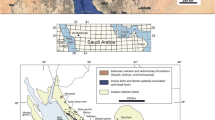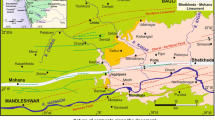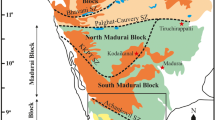Abstract
Mafic dyke swarms, when controlled by a regional stress field, are emplaced perpendicular to the minimum principal compressive stress direction. However, mafic dyke swarms may also exploit pre-existing structural fabric in their host rocks. Distinguishing between the two scenarios is important for correct geodynamic understanding of magmatic events. Continental flood basalt provinces such as the Deccan Traps of India represent huge fissure eruptions produced by swarms of mafic dykes. The Coastal dyke swarm of the Deccan, along the western Indian rifted margin, is one of its three major dyke swarms. We present a field study of the Goa dykes, part of the Coastal swarm. The dykes are typical dolerites and basalts exposed in Proterozoic-age basement; lava flows which these dykes may have once fed have been stripped away by erosion, though exposed in the Western Ghats escarpment ~ 100 km to the east. The Goa dyke swarm contains 60 dykes, some of which form larger multiple-injection dykes. The dykes are short compared to typical (kilometers or tens of kilometers long) dykes in flood basalt provinces such as the Deccan or Iceland, and range in length from ~ 15 to ~ 220 m and in thickness from 3 cm to 20 m. Most dykes are vertical and the others dip steeply in various directions. Their structural attributes and internal features (such as vesicular zones and columnar jointing) provide clues to the processes of magma flow and solidification in the dykes. Field measurements yield an average crustal dilation of 8% due to dyke emplacement. Calculations of magmatic overpressures and magma chamber depths generally yield unrealistic values owing to the low aspect ratios of the dykes. Based on comparisons between the dyke trends and the host rock joint trends, we consider that a few of the Goa dykes were emplaced along pre-existing fractures, but the orientations of the great majority of the dykes reflect contemporaneous stress fields. Based on crosscutting relationships, we infer that the regional minimum horizontal compressive stress (σ3) changed over time from a ~E-W orientation to a ~NE-SW orientation and finally to a ~N-S direction.












Similar content being viewed by others
References
Airoldi G, Muirhead JD, White J, Rowland J (2011) Emplacement of magma at shallow depth: insights from field relationships at Allan Hills, South Victoria Land, East Antarctica. Antarct Sci 23:281–296
Ancochea E, Brändle JL, Huertas MJ, Cubas CR, Hernán F (2003) The felsic dykes of La Gomera (Canary Islands): identification of cone sheet and radial dyke swarms. J Volcanol Geotherm Res 120:197–206
Auden JB (1949) Dykes in western India: a discussion of their relationships with the Deccan Trap. Trans Nat Inst Sc India 3:123–157
Babiker M, Gudmundsson A (2004) Geometry, structure and emplacement of mafic dykes in the Red Sea hills, Sudan. J Afr Earth Sci 38:279–292
Baer G, Beyth M, Reches Z (1994) Dykes emplaced into fractured basement, Timna igneous complex, Israel. J Geophys Res 99:24039–24050
Baksi AK (2014) The Deccan Trap – Cretaceous-Paleogene boundary connection; new 40Ar/39Ar ages and critical assessment of existing argon data pertinent to this hypothesis. J Asian Earth Sci 84:9–23
Basavaiah N, Satyanarayana KVV, Deenadayalan K, Prasad JN (2018) Does Deccan volcanic sequence contain more reversals than the three-Chron N-R-N flow magnetostratigraphy ? – a palaeomagnetic evidence from the dyke-swarm near Mumbai. Geophys J Int 213:1503–1523
Beane JE, Turner CA, Hooper PR, Subbarao KV, Walsh JN (1986) Stratigraphy, composition and form of the Deccan basalts, Western Ghats, India. Bull Volcanol 48:61–83
Bhattacharji S, Chatterjee N, Wampler JM, Nayak PN, Deshmukh SS (1996) Indian intraplate and continental margin rifting, lithospheric extension and mantle upwelling in Deccan flood basalt volcanism near the K/T boundary: evidence from mafic dyke swarms. J Geol 104:379–398
Bondre NR, Hart WK, Sheth HC (2006) Geology and geochemistry of the Sangamner mafic dyke swarm, western Deccan volcanic province, India: implications for regional stratigraphy. J Geol 114:155–170
Cadman A, Tarney J, Park RG (1990) Intrusion and crystallization features in Proterozoic dyke swarms. In: Parker AJ, Rickwood PC, Tucker DH (eds) Mafic dykes and emplacement mechanisms. Balkema, Rotterdam, pp 13–24
Cox KG, Hawkesworth CJ (1984) Relative contributions of crust and mantle to flood basalt magmatism, Mahabaleshwar area, Deccan Traps. Philos Trans R Soc Lond A 310:627–641
Cucciniello C, Choudhary AK, Zanetti A, Sheth HC, Vichare S, Pereira R (2014) Mineralogy, geochemistry and petrogenesis of the Khopoli mafic intrusion, Deccan Traps, India. Mineral Petrol 108:333–351
Cucciniello C, Demonterova EI, Sheth H, Pande K, Vijayan A (2015) 40Ar/39Ar geochronology and geochemistry of the Central Saurashtra mafic dyke swarm: insights into magmatic evolution, magma transport, and dyke-flow relationships in the northwestern Deccan Traps. Bull Volcanol 77, art 45, https://doi.org/10.1007/s00445-015-0932-0
Currie KL, Ferguson J (1970) The mechanism of intrusion of lamprophyre dykes indicated by “offsetting” of dykes. Tectonophysics 9:525–535
Daniels KA, Kavanagh JL, Menand TJ, Sparks RSJ (2012) The shapes of dykes: evidence for the influence of cooling and inelastic deformation. Geol Soc Am Bull 124:1102–1112
DeGraff JM, Aydin A (1987) Surface morphology of columnar joints and its significance to mechanics and direction of joint growth. Geol Soc Am Bull 99:605–617
Deshmukh SS, Sehgal MN (1988) Mafic dyke swarms in Deccan volcanic province of Madhya Pradesh and Maharashtra. In: Subbarao KV (ed) Deccan flood basalts. Geol Soc Ind Mem 10:323–340
Dessai AG (2011) The geology of the Goa Group: revisited. J Geol Soc India 78:233–242
Dessai AG (2018) Geology and mineral resources of Goa. New Delhi Publ, Delhi
Dessai AG, Viegas AAAA (1995) Multigeneration mafic dyke swarm related to Deccan magmatism, south of Bombay: implications on the evolution of the western continental margin. In: Devaraju TC (ed) Dyke swarms of peninsular India. Geol Soc Ind Mem 33:435–451
Devey CW, Lightfoot PC (1986) Volcanological and tectonic control of stratigraphy and structure in the western Deccan traps. Bull Volcanol 48:195–207
Ernst RE, Buchan KL, Palmer HC (1995) Giant dyke swarms: characteristics, distribution and geotectonic applications. In: Baer G, Heimann A (eds) Physics and chemistry of dykes. Balkema, Rotterdam, pp 3–21
Fernandez OA (2009) Physiography and general geology of Goa. In: Mascarenhas A, Kalavampara G (eds) Natural resources of Goa: a geological perspective. Geol Soc Goa, Panjim, pp 11–24
Fialko YA, Rubin AM (1999) Thermal and mechanical aspects of magma emplacement in giant dyke swarms. J Geophys Res 104(B10):23033–23049
Gadgil R, Miranda MA, Viswanath TA (2018) Deformational features of intraformational para-conglomerate of the Palaeoproterozoic Sanvordem formation, Goa group indicates a brittle-ductile dextral shear. Int J Geom Geosc 8:24–40
Galindo I, Gudmundsson A (2012) Basaltic feeder dykes in rift zones: geometry, emplacement and effusion rates. Nat Hazards Earth Syst Sci 12:3683–3700
Gautneb H, Gudmundsson A, Oskarsson N (1989) Structure, petrochemistry and evolution of a sheet swarm in an Icelandic central volcano. Geol Mag 126:659–673
Geshi N (2005) Structural development of dyke swarms controlled by the change of magma supply rate: the cone sheets and parallel dykes swarms of the Miocene Otoge igneous complex, central Japan. J Volcanol Geotherm Res 141:267–281
Gokul AR (1985) Structure and tectonics of Goa. In: Earth’s resources for Goa’s development, pp 14–21
Greenland LP, Okamura AT, Stokes JB (1988) Constraints on the mechanics of the eruption. In: Wolfe EW (ed) The P’u’u ‘O’o eruption of Kilauea Volcano, Hawaii: episodes 1 through 20, January 3, 1983 through June 8, 1984. US Geol Surv prof pap 1463:155–164
Grossenbacher KA, McDuffie SM (1995) Conductive cooling of lava: columnar joint diameter and stria width as functions of cooling rate and thermal gradient. J Volcanol Geotherm Res 69:95–103
Gudmundsson A (1983) Form and dimensions of dykes in eastern Iceland. Tectonophysics 34(3–4):81–96
Gudmundsson A (1984) Formation of dykes, feeder dykes and the intrusion of dykes from magma chambers. Bull Volcanol 47:537–550
Gudmundsson A (1995) The geometry and growth of dykes. In: Baer G, Heinmann A (eds) Physics and chemistry of dykes. Balkema, Rotterdam, pp 23–34
Gudmundsson A (2011) Rock fractures in geological processes. Cambridge Univ Press, 578 p
Gudmundsson A, Loetveit IF (2005) Dyke emplacement in a layered and faulted rift zone. J Volcanol Geotherm Res 144:311–327
Halls HC (1982) The importance and potential of mafic dyke swarms in studies of geodynamic processes. Geosci Can 9:145–154
Hansen SE, Sorlokk T, Johannsson AE (1998) Mechanical properties of rocks. SINTEF report, STF22 A98034, Trondheim
Hoek JD (1991) A classification of dyke-fracture geometry with examples from Precambrian dyke swarms in the Vestfold Hills, Antarctica. Geol Rundsch 80:233–248
Hooper PR, Widdowson M, Kelley S (2010) Tectonic setting and timing of the final Deccan flood basalt eruptions. Geology 38:839–842
Hou GT, Kusky TM, Wang CC, Wang YX (2010) Mechanics of the giant radiating MacKenzie dyke swarm: a palaeostress field modelling. J Geophys Res 115(B02402). https://doi.org/10.1029/2007JB005475
Iyer SD, Wagle BG (1987) Morphometric analysis of the river basins in Goa. Geogr Rev Ind 49:11–18
Iyer SD, Banerjee G, Wagle BG (1989) Statistical analysis of lineaments of Goa. India Curr Sci 58:1316–1319
Iyer SD, Wagle BG, D’Cruz EE (1990) Dyke swarms along the Goa coast, India. Nat Sem Rec Rec Geol West Ind, MS Univ, Vadodara, p 14
Ju W, Hou GT, Hari KR (2013) Mechanics of mafic dyke swarms in the Deccan large igneous province: palaeostress field modelling. J Geodyn 66:79–91
Long PE, Wood BJ (1986) Structures, textures, and cooling histories of Columbia River basalt flows. Geol Soc Am Bull 97:1144–1155
Lyle P (2000) The eruption environment of multi-tiered columnar basalt lava flows. J Geol Soc Lond 157:715–722
Mahoney JJ (1988) Deccan traps. In: Macdougall JD (ed) Continental flood basalts. Kluwer Acad Publ, Dordrecht, pp 151–194
Marinoni LB (2001) Crustal extension from exposed sheet intrusions: review and method proposal. J Volcanol Geotherm Res 107:27–46
Marinoni LB, Gudmundsson (2000) Dykes, faults and palaeostresses in the Teno and Anaga massifs of Tenerife (Canary Islands). J Volcanol Geotherm Res 103:83–103
Martha TK, Ghosh D, Vinod Kumar K, Lesslie A, Ravi Kumar MV (2013) Geospatial technologies for national geomorphology and lineament mapping project – a case study for Goa state. J Indian Soc Remote 41:905–920
Martinez-Poza AI, Druguet E, Castano LM, Carreras J (2014) Dyke intrusion into a pre-existing joint network: the Aiguablava lamprophyre dyke swarm (Catalan coastal ranges). Tectonophysics 630:75–90
McHone JG, Anderson DL, Beutel EK, Fialko YA (2005) Giant dykes, rifts, flood basalts, and plate tectonics: a contention of mantle models. In: Foulger GR, Natland JH, Presnall DC, Anderson DL (eds), Plates, plumes, and paradigms. Geol Soc Am Spec Pap 388:401–420
Mège D, Korme T (2004) Dyke swarm emplacement in the Ethiopian large igneous province: not only a matter of stress. J Volcanol Geotherm Res 132:283–310
Melluso L, Sethna SF, Morra V, Khateeb A, Javeri P (1999) Petrology of the mafic dyke swarm of the Tapti River in the Nandurbar area (Deccan volcanic province). In: Subbarao KV (ed) Deccan volcanic province. Geol Soc Ind Mem 43:735–755
Nicholson R, Pollard DD (1985) Dilation and linkage of echelon cracks. J Struct Geol 7:583–590
Nogueira CR, Terrinha P, Moreira M (2009) Assessing magma flow direction in dykes from vesicle shapes and orientations. Geophys Res Abstr (EGU), p13369
Pande K, Vadakkeyakath Y, Sheth H (2017) 40Ar/39Ar dating of the Mumbai tholeiites and Panvel flexure: intense 62.5 Ma onshore–offshore Deccan magmatism during India-Laxmi Ridge–Seychelles breakup. Geophys J Int 210:1160–1170
Paquet F, Dauteuil O, Hallot E, Moreau F (2007) Tectonics and magma dynamics coupling in a dyke swarm of Iceland. J Struct Geol 29:1477–1493
Parfitt EA, Wilson L (2008) Fundamentals of physical volcanology. Blackwell Publ, 230 p
Park JK, Buchan KL, Harlan SL (1995) A proposed giant radiating dyke swarm fragmented by the separation of Laurentia and Australia based on palaeomagnetism of ca. 780 Ma mafic intrusions in western North America. Earth Planet Sci Lett 132:129–139
Patil SK, Rao DR (2002) Palaeomagnetic and rock magnetic studies on the dykes of Goa, west coast of Indian Precambrian shield. Phys Earth Planet Inter 133:111–125
Pinel V, Jaupart C (2004) Likelihood of basaltic eruptions as a function of volatile content and volcanic edifice size. J Volcanol Geotherm Res (110):1–15
Platten IM (1995) Flow and crystallization in dykes: a review of field and laboratory data in the light of recent advances in mathematical modelling. In: Devaraju TC (ed) Dyke swarms of peninsular India. Geol Soc Ind Mem 33:1–47
Pollard DD (1973) Derivation and evaluation of a mechanical model for sheet intrusions. Tectonophysics 19:233–269
Pollard DD, Segall P, Delaney PT (1982) Formation and interpretation of dilatant echelon cracks. Geol Soc Am Bull 93:1291–1303
Powar KB, Vadetwar SB (1995) Mineralogy and geochemistry of basic dykes and associated plugs of the Revas-Murud sector, Konkan coastal belt, Maharashtra. In: Devaraju TC (ed) Dyke swarms of peninsular India. Geol Soc Ind Mem 33:339–363
Prabhakar Rao P, Raju AV, Nair MM (1985) Geomorphology of Goa. Earth’s resources for Goa’s development. Panjim: Goa seminar Vol pp 583–586
Ray R, Sheth HC, Mallik J (2007) Structure and emplacement of the Nandurbar-Dhule mafic dyke swarm, Deccan Traps, and the tectonomagmatic evolution of flood basalts. Bull Volcanol 69:537–551
Renne PR, Sprain CJ, Richards MA, Self S, Vanderkluysen L, Pande K (2015) State shift in Deccan volcanism at the Cretaceous-Palaeogene boundary, possibly induced by impact. Science 350:76–78
Samant H, Patel V, Pande K, Sheth HC, Jagadeesan KC (2019) 40Ar/39Ar dating of tholeiitic flows and dykes of Elephanta Island, Panvel flexure zone, western Deccan Traps: A five-million-year record of magmatism preceding India-Laxmi Ridge-Seychelles breakup. J Volcanol Geotherm Res 379:12-22
Schirnick C, Bogaard PV, Schmincke H-U (1999) Cone sheet formation and intrusive growth of an oceanic island — the Miocene Tejada complex on Gran Canaria (Canary Islands). Geology 27:207–210
Sheth H (2018) A photographic atlas of flood basalt volcanism. Springer, New York, p 383
Sheth HC, Cañón-Tapia E (2015) Are flood basalt eruptions monogenetic or polygenetic? Int J Earth Sci (Geol Rund) 104:2147–2162
Sheth HC, Melluso L (2008) The Mount Pavagadh volcanic suite, Deccan traps: geochemical stratigraphy and magmatic evolution. J Asian Earth Sci 32:5–21
Sheth HC, Ray JS, Ray R, Vanderkluysen L, Mahoney JJ, Kumar A, Shukla AD, Das P, Adhikari S, Jana BK (2009) Geology and geochemistry of Pachmarhi dykes and sills, Satpura Gondwana Basin, Central India: problems of dyke-sill-flow correlations in the Deccan Traps. Contrib Mineral Petrol 158:357–380
Sheth HC, Zellmer GF, Kshirsagar PV, Cucciniello C (2013) Geochemistry of the Palitana flood basalt sequence and the eastern Saurashtra dykes, Deccan traps: clues to petrogenesis, dyke-flow relationships, and regional lava stratigraphy. Bull Volcanol 75:art 701. https://doi.org/10.1007/s00445-013-0701-x
Sheth HC, Zellmer GF, Demonterova EI, Ivanov AV, Kumar R, Patel RK (2014) The Deccan tholeiite lavas and dykes of Ghatkopar–Powai area, Mumbai, Panvel flexure zone: geochemistry, stratigraphic status, and tectonic significance. J Asian Earth Sci 84:69–82
Sheth HC, Meliksetian K, Gevorgyan H, Israyelyan A, Navasardyan G (2015) Intercanyon basalt lavas of the Debed River (northern Armenia), part of a Pliocene-Pleistocene continental flood basalt province in the South Caucasus. J Volcanol Geotherm Res 295:1–15
Sheth HC, Vanderkluysen L, Demonterova EI, Ivanov AV, Savatenkov VM (2019) Geochemistry and 40Ar/39Ar geochronology of the Nandurbar-Dhule mafic dyke swarm: dyke-sill-flow correlations and stratigraphic development across the Deccan flood basalt province. Geol J 54:157–176
Sneddon IN, Lowengrub M (1969) Crack problems in the classical theory of elasticity. John Wiley, New York, p 221
Song S-R, Lo H-J (2002) Lithofacies of volcanic rocks in the central coastal range, eastern Taiwan: implications for island arc evolution. J Asian Earth Sci 21:23–38
Sparks RSJ (1978) The dynamics of bubble formation and growth in magmas: a review and analysis. J Volcanol Geotherm Res 3:1–37
Su Y, Huber C, Bachmann O, Zajacz Z, Wright H, Vazquez J (2016) The role of crystallization-driven exsolution on the sulfur mass balance in volcanic arc magmas. J Geophys Res 121:5624–5640
Swanson DA, Wright RL, Helz RT (1975) Linear vent systems and estimated rates of magma production and eruption for the Yakima basalt on the Columbia plateau. Am J Sci 275:877–905
Vanderkluysen L, Mahoney JJ, Hooper PR, Sheth HC, Ray R (2011) The feeder system of the Deccan Traps (India): insights from dyke geochemistry. J Petrol 52:315–343
Varga RJ, Gee JS, Staudigel H, Tauxe L (1998) Dyke surface lineations as magma flow indicators within the sheeted dike complex of the Troodos Ophiolite, Cyprus. J Geophys Res 103(B3):5241–5256
Vijayan A, Sheth H, Sharma KK (2016) Tectonic significance of dykes in the Sarnu-Dandali alkaline complex, Rajasthan, northwestern Deccan Traps. Geosci Front 7:783–791
Wagle BG, Rajamanickam GV (1980) A petrographic study of Precambrian quartzites from Goa coast. Mahasagar-Bull Nat Inst Oceano 13:9–21
Widdowson M, Gunnell Y (1999) Lateritization, geomorphology and geodynamics of a passive continental margin: the Konkan and Kanara coastal lowlands of western peninsular India. Spec Publ Int Assoc Sed 27:245–274
Widdowson M, Pringle MS, Fernandez OA (2000) A post K-T boundary (Early Palaeocene) age for Deccan-type feeder dykes, Goa, India. J Petrol 41:1177–1194
Wilson L, Head JW (1981) Ascent and eruption of basaltic magma on the Earth and Moon. J Geophys Res 86:2791–3001
Yong Technology, Inc. (2014) GeoRose. Edmonton, Canada. http://www.yongtechnology.com/download/georose. Accessed 12 July 2016
Acknowledgements
This work forms a part of the PhD dissertation of Raghav Gadgil at Goa University. Gadgil is grateful to all his dissertation and project students of 2014-2019 batches at Goa University and Dhempe College, and especially to Akshay Tari for the valuable field assistance on many occasions. He also thanks his wife Shweta Gadgil for domestic support and encouragement in this research. He is grateful to Tapas Kumar Biswal, Paul Bons, Elena Druguet, Agust Gudmundsson, and Hetu Sheth for the helpful email discussions over the past several years, Peter C. Rickwood and Rajesh K. Srivastava for providing relevant literature, and Hetu Sheth for the photograph in Fig. 6c. Goa University and Dhempe College of Arts and Science are acknowledged for hosting this study. Sridhar D. Iyer thanks the Director, CSIR-NIO for providing facilities. The authors thank Hetu Sheth and Agust Gudmundsson for the detailed and constructive reviews and Valerio Acocella and Andrew Harris for their editorial handling and valuable comments that greatly improved this manuscript.
Author information
Authors and Affiliations
Corresponding author
Additional information
Editorial responsibility: V. Acocella
Rights and permissions
About this article
Cite this article
Gadgil, R., Viegas, A. & Iyer, S.D. Structure and emplacement of the Coastal Deccan tholeiitic dyke swarm in Goa, on the western Indian rifted margin. Bull Volcanol 81, 35 (2019). https://doi.org/10.1007/s00445-019-1297-6
Received:
Accepted:
Published:
DOI: https://doi.org/10.1007/s00445-019-1297-6




